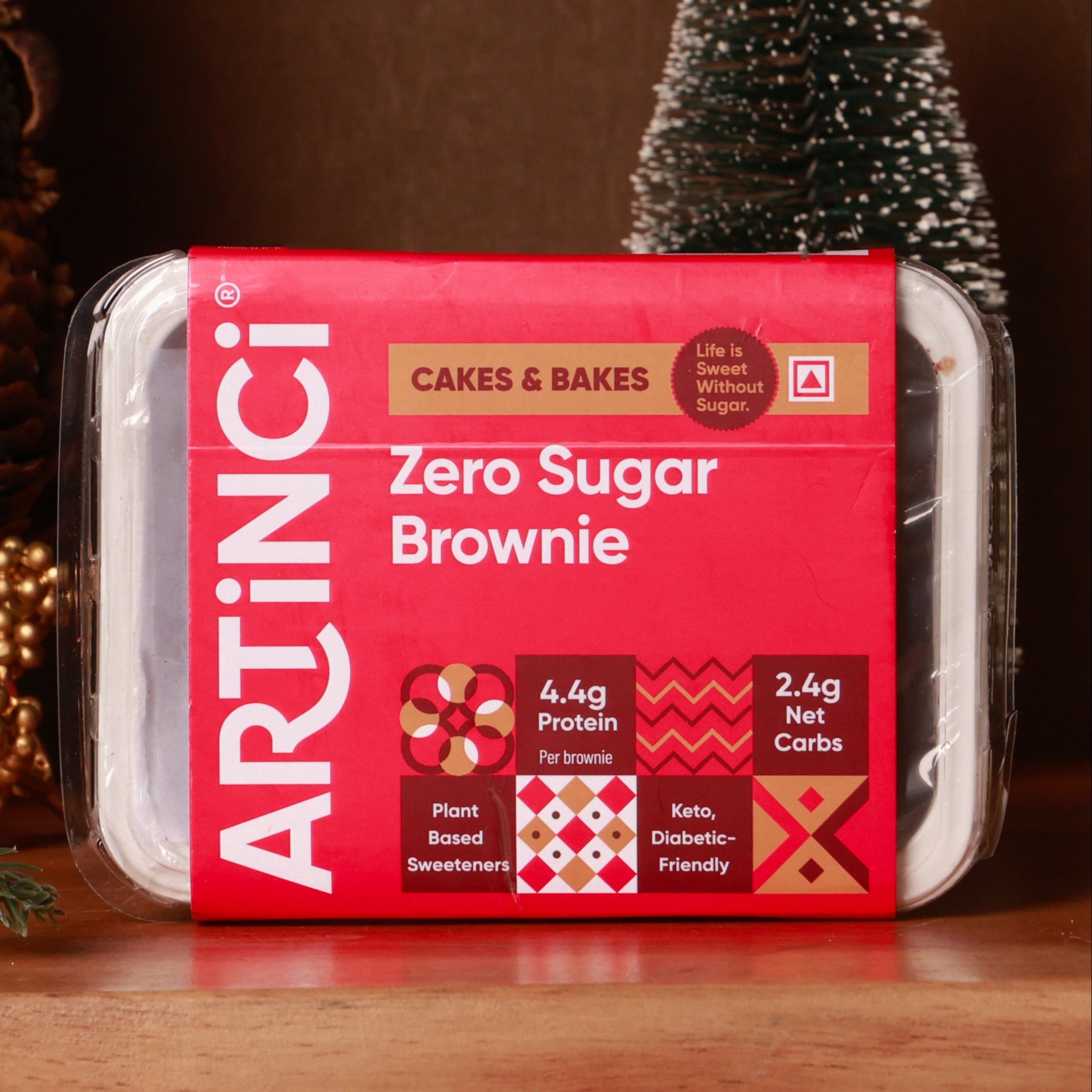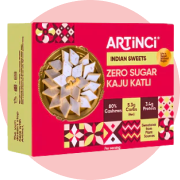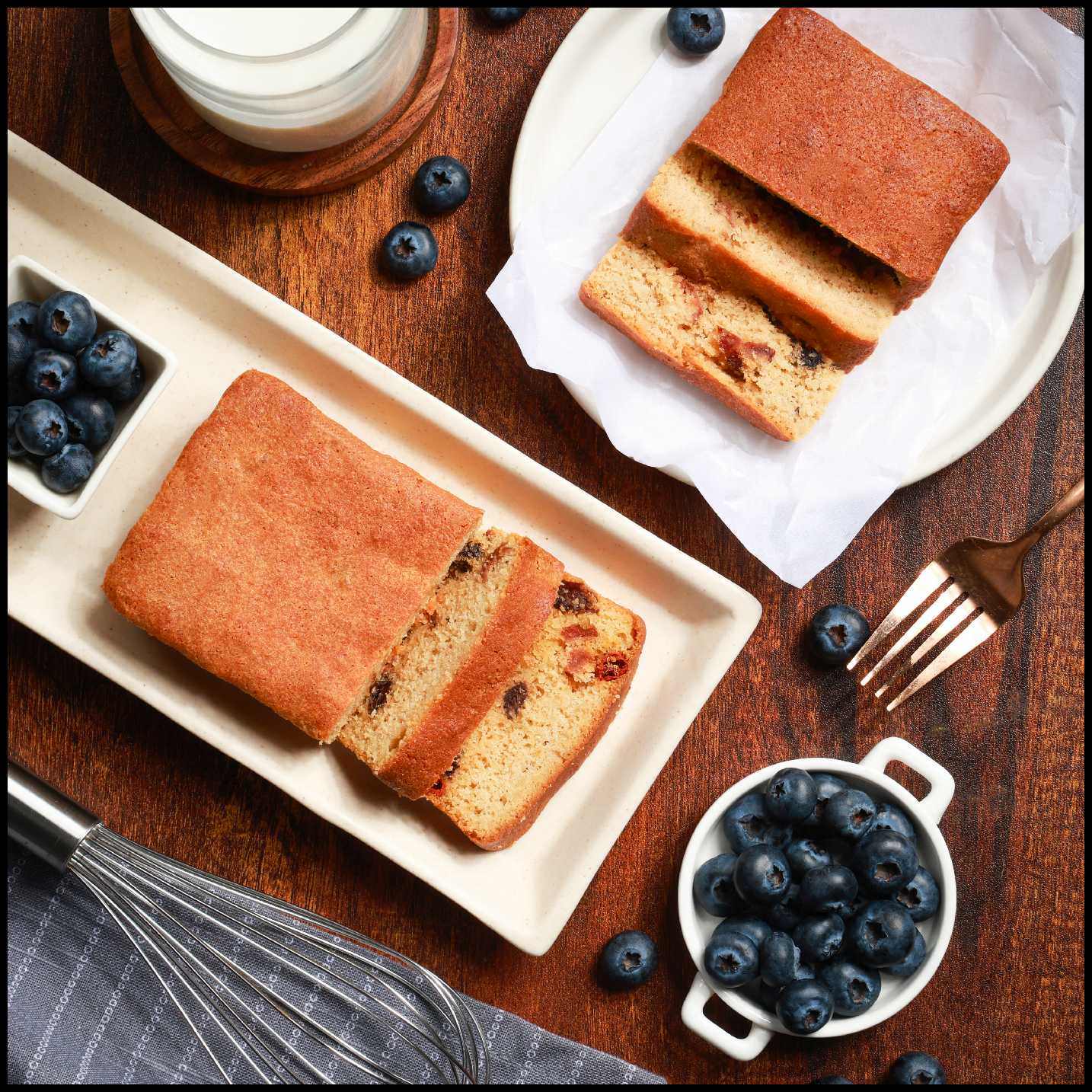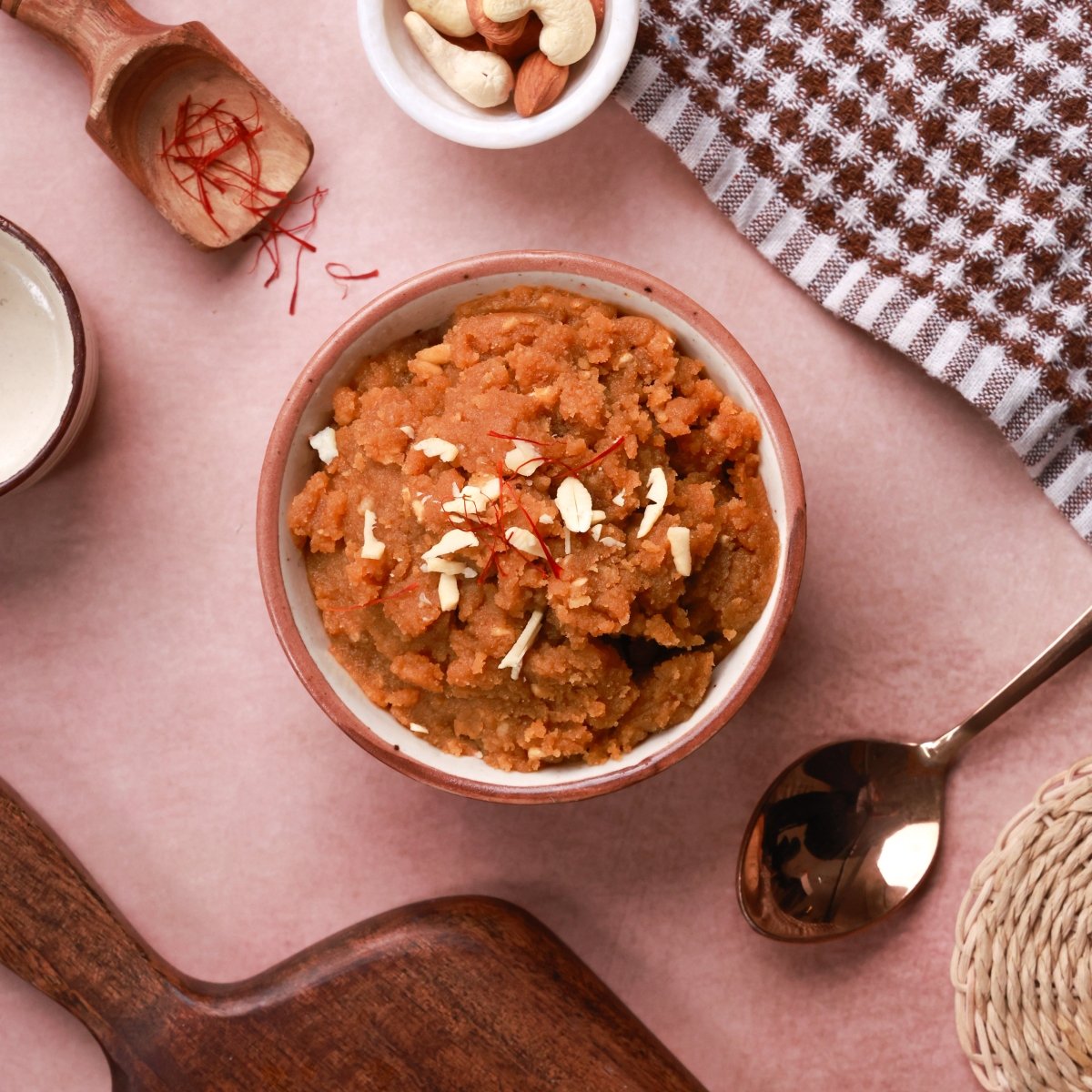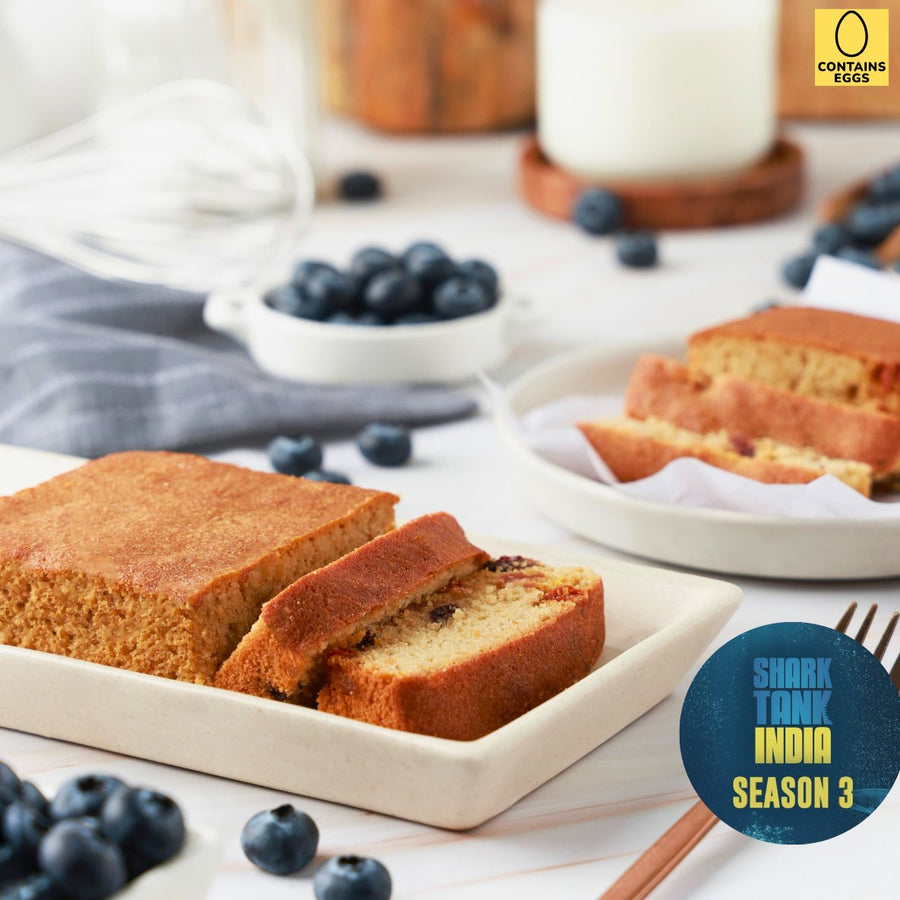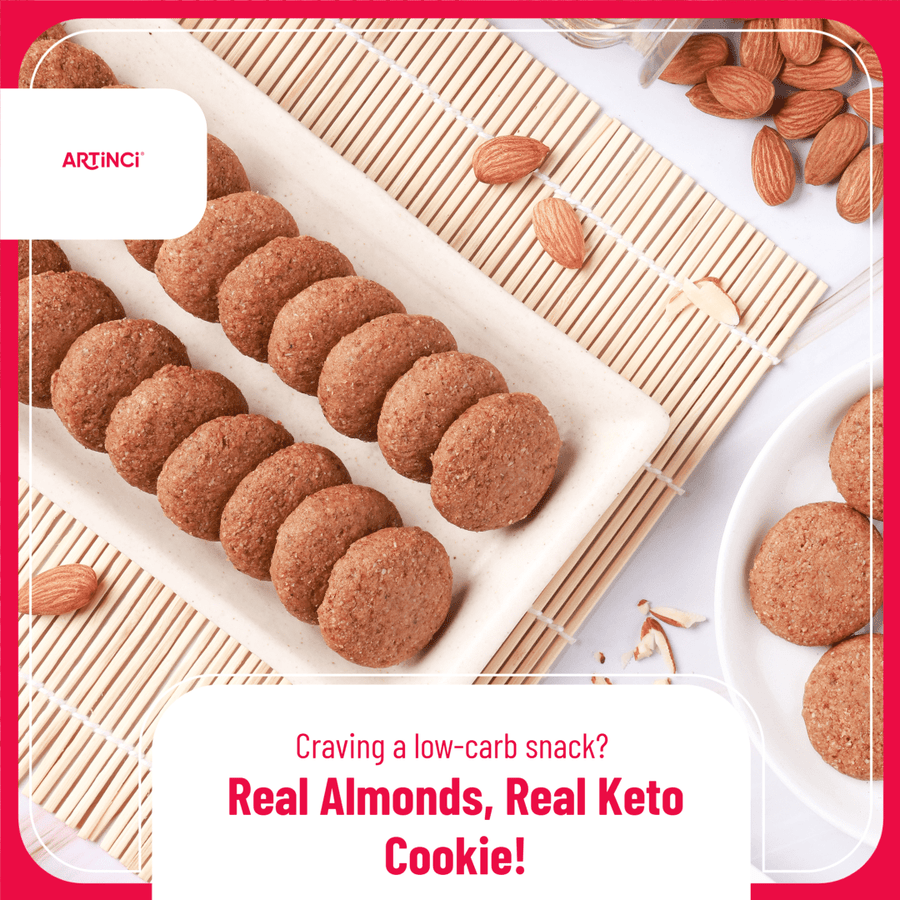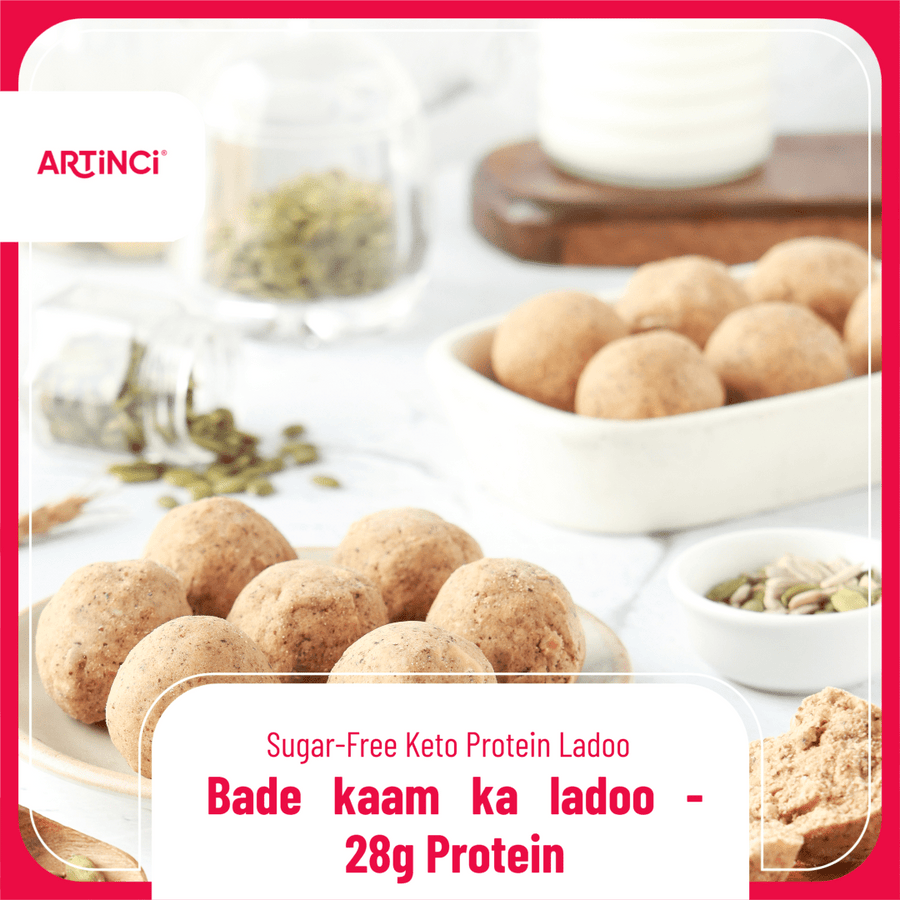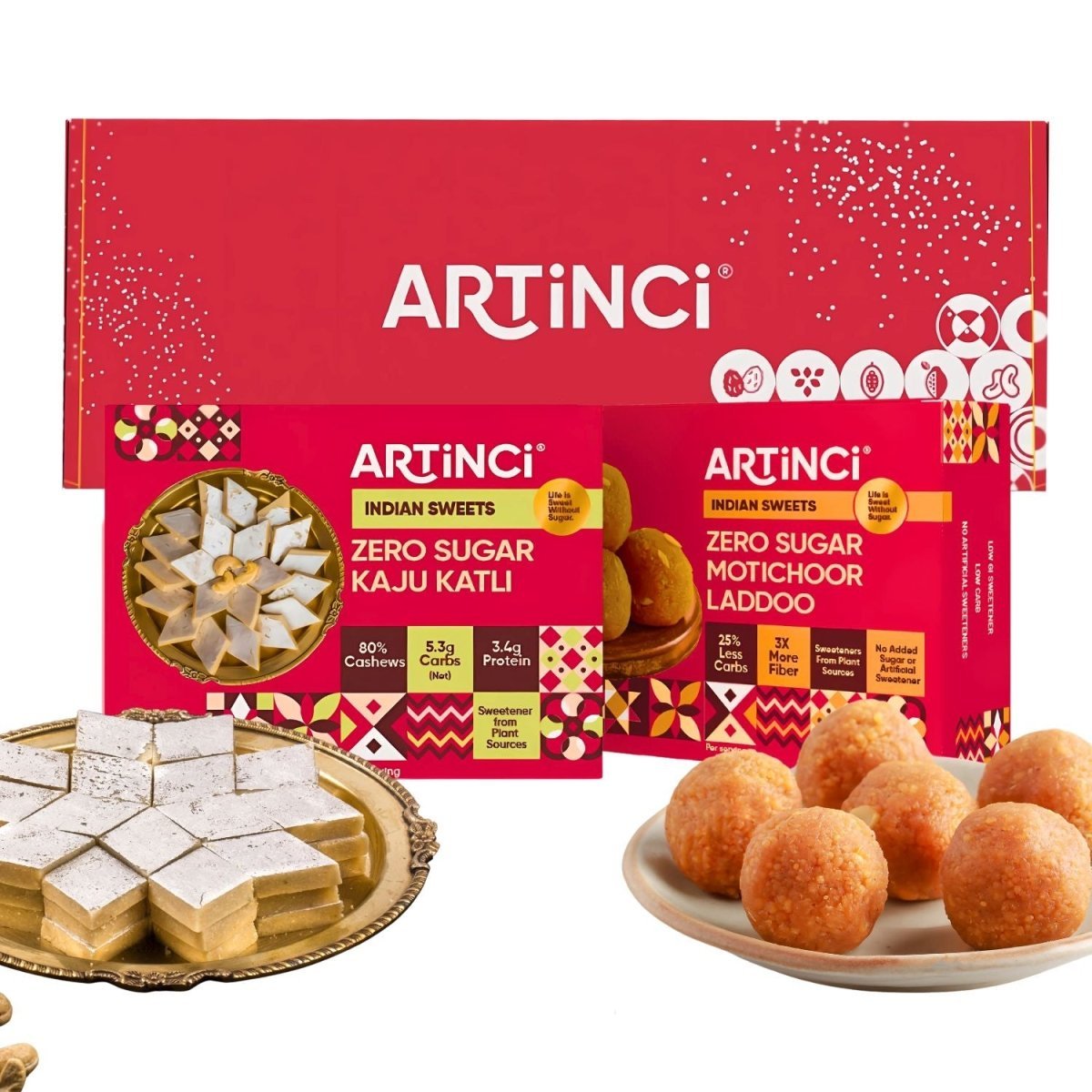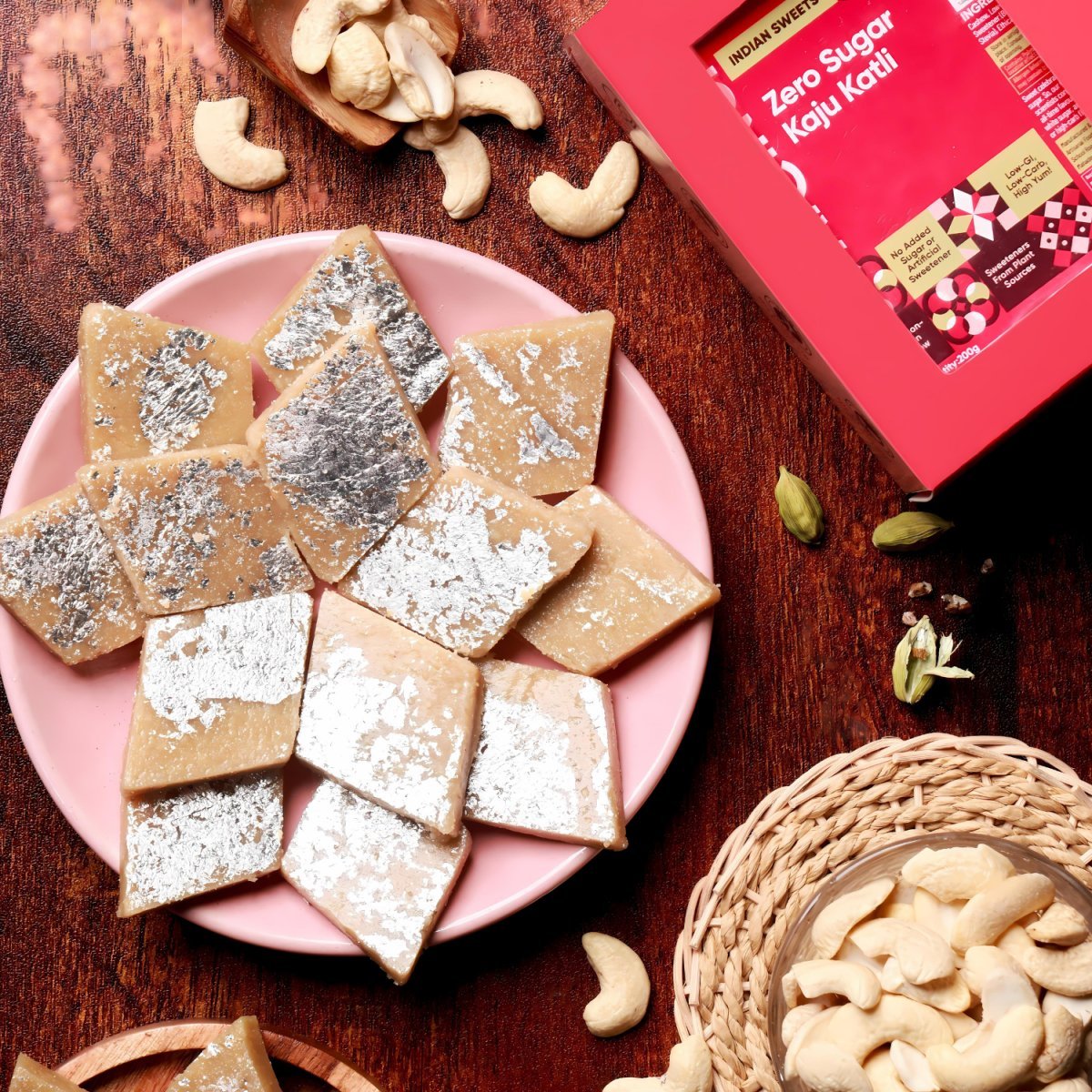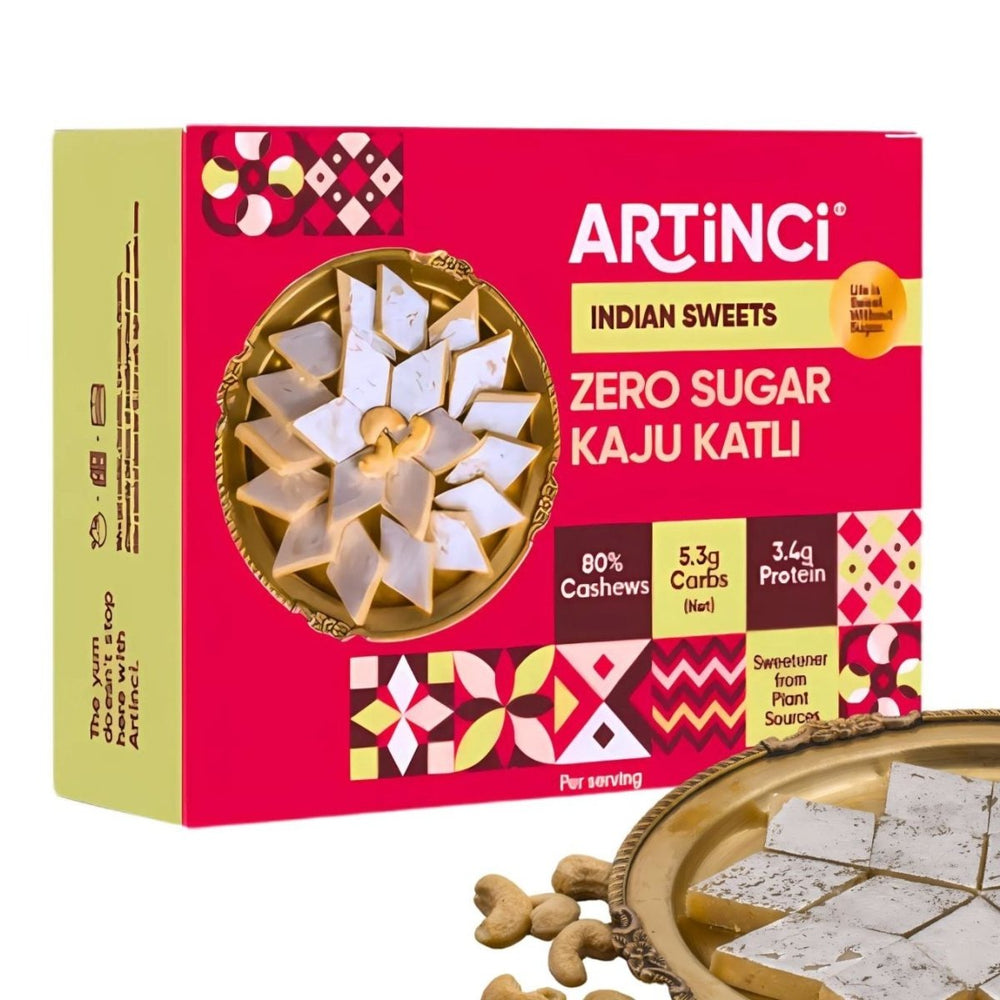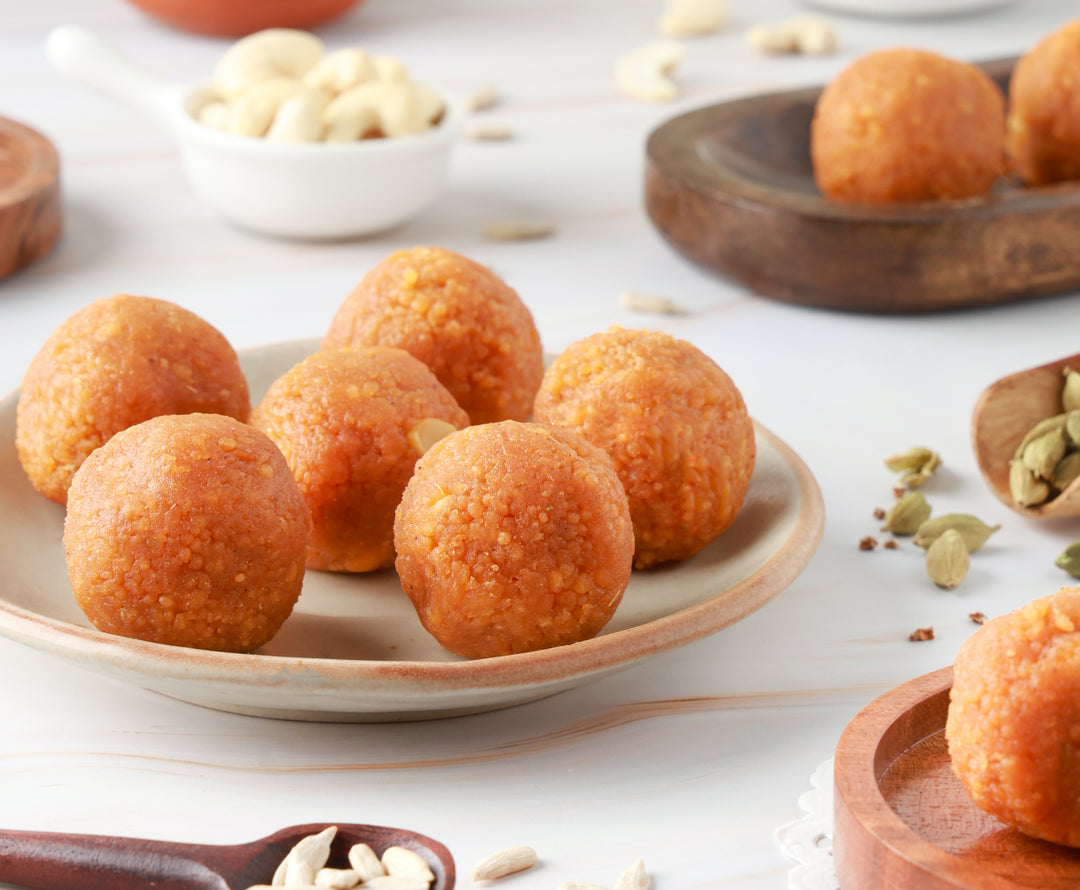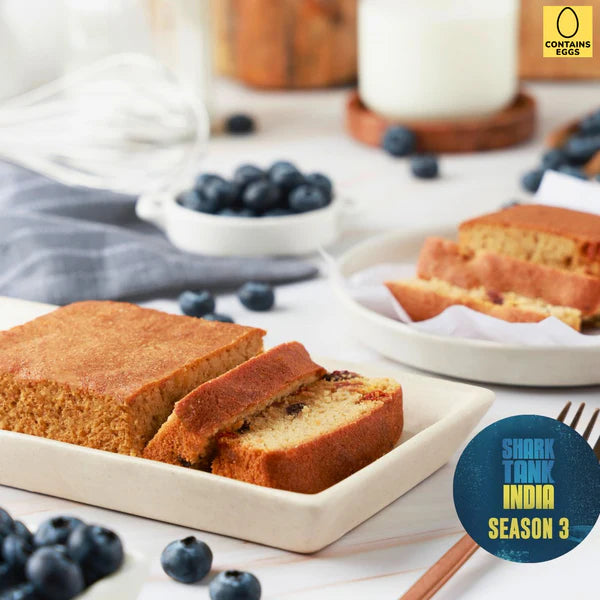Welcome to the world of sugar free joy!
Low Carb Sugar-Free Desserts & Snacks
Artinci was born out of Aarti's and Sumit's (Artinci's founders) abiding love for great-tasting dessert, while helping them stay committed to their health goals as well. As a result, Artinci makes delicious desserts with zero sugar, that are science and evidence-backed.
Aarti and Sumit come from a family of three generations of diabetics. They were themselves diagnosed pre-diabetic in 2012, and right there began a lifelong quest of a healthy, active lifestyle, including healthy swaps in food
Indulgent Halwas & Cozy Cakes


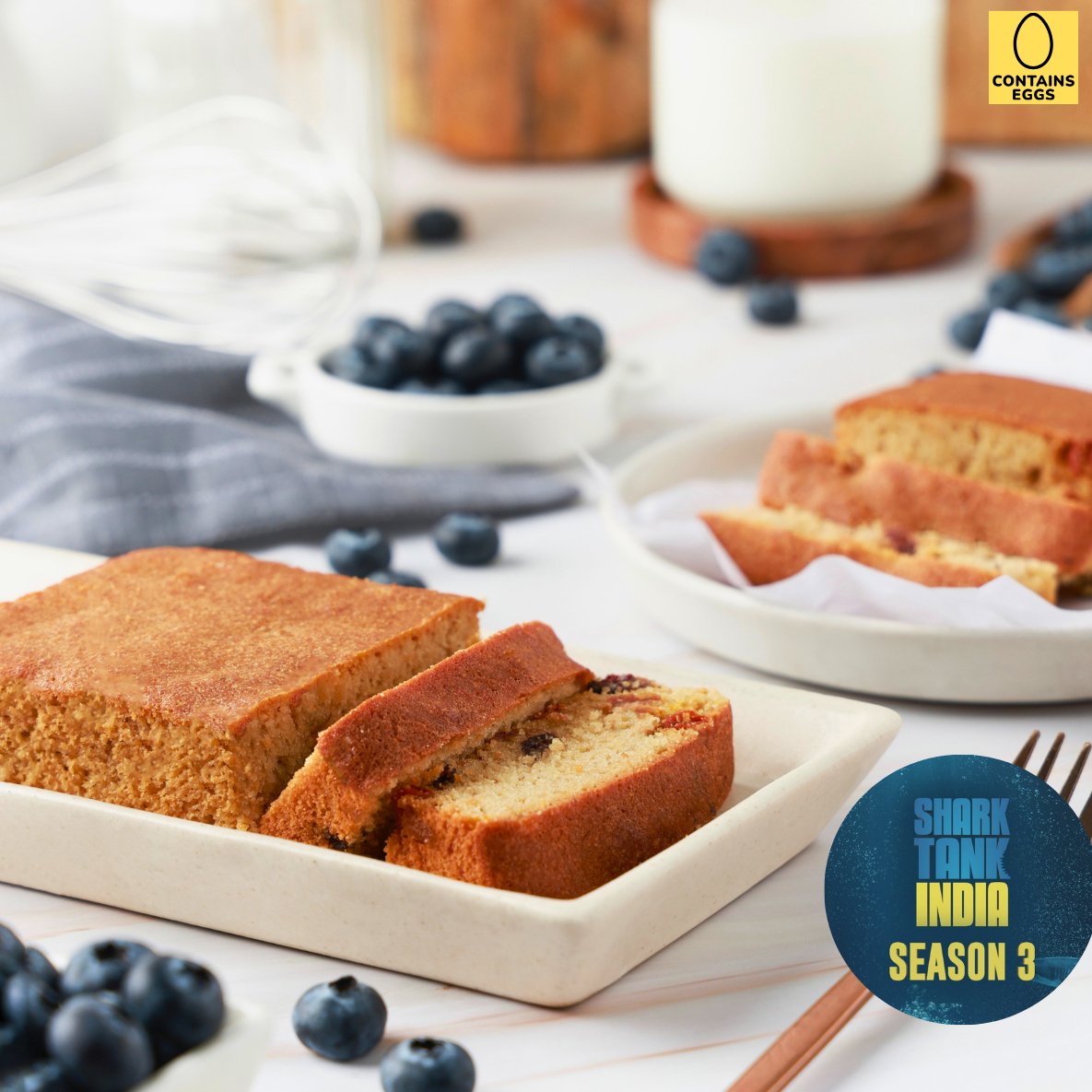


Berries Almond Cake - Made with 100% Almond Flour, Sugar Free, Keto, Gluten Free

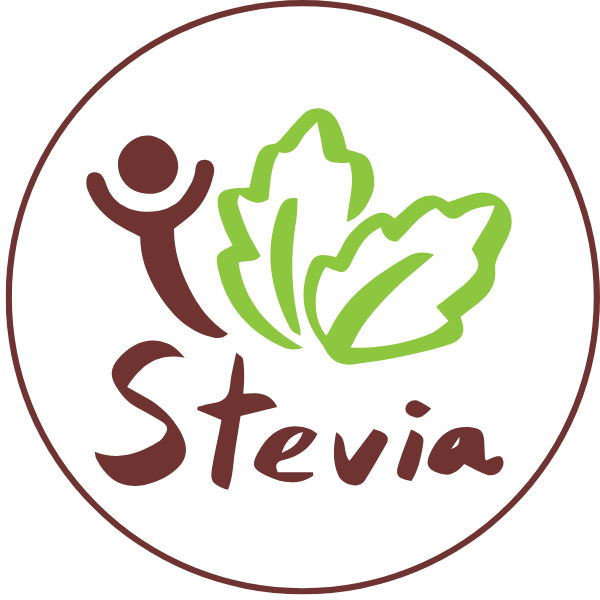

Winter special sugar free halwa combo @499



Aarti Laxman (Founder)
Artinci is founded by Aarti Laxman, a certified Metabolic coach in the Low-Carb Nutrition & Metabolic Health domain from dLife.in, India’s only legally tenable course in this subject—recognized by the NSDC (under the Ministry of Skill Development & Entrepreneurship, Govt. of India). It’s also internationally accredited by the CPD Standards Office UK, with a global record of 144 CPD hours—the highest for any course of its kind. The accreditation is both nationally valid and globally recognised in over 50+ countries..
Festive Gifting in Artinci
Let customers speak for us
All about Sugar and sugar-free

Living with diabetes doesn't mean giving up the joy of baking. Natural sweeteners have changed the way people with diabetes enjoy their favorite treats. Three standout options - stevia, monk fruit, and erythritol - have become popular for their ability to provide sweetness without raising blood sugar levels. In this guide, you'll discover: The science behind each sweetener's effect on blood sugar Specific health benefits for diabetic individuals Practical baking tips and conversion ratios Safety considerations and potential side effects Expert recommendations for daily consumption Whether you're new to diabetic-friendly baking or looking to expand your knowledge of sugar alternatives, this guide will help you make informed choices about natural sweeteners. You'll learn how to create delicious baked goods that align with your health goals, using these powerful plant-based alternatives to traditional sugar. Ready to transform your baking experience? Let's explore these game-changing natural sweeteners that are reshaping diabetic-friendly cuisine. 1. Stevia: A Powerful Sugar Substitute Stevia's journey from ancient sweetener to modern sugar alternative began with the Guarani people of South America, who used the leaves of Stevia rebaudiana to sweeten their traditional yerba mate tea. This remarkable plant produces compounds called steviol glycosides, making it 200-400 times sweeter than regular table sugar. The natural sweetening power of stevia comes from its unique molecular structure. Unlike artificial sweeteners, stevia extract contains zero calories and carbohydrates, making it an ideal choice for blood sugar management. Health Benefits for Diabetics Stevia offers significant advantages for people managing diabetes: Stimulates insulin production Helps stabilize blood glucose levels Contains antioxidant properties Supports weight management goals Reduces sugar cravings Research indicates stevia's antidiabetic properties extend beyond simple sugar replacement. Studies show it can improve insulin sensitivity and reduce post-meal blood glucose spikes. FDA Approval and Safety Guidelines The FDA has granted GRAS (Generally Recognized as Safe) status to high-purity stevia extracts. You'll find approved stevia products in several forms: Liquid drops Powdered extracts Granulated blends Baking mixes While stevia is safe for most people, some individuals might experience mild side effects: Slight digestive discomfort Subtle bitter aftertaste Potential interactions with certain medications To minimize these effects, start with small amounts and adjust gradually. The FDA recommends a daily intake limit of 4 mg per kilogram of body weight for steviol glycosides. When selecting stevia products, look for high-purity extracts labeled as "purified stevia" or "stevia extract." These forms offer the most consistent results for diabetic-friendly baking while maintaining optimal safety standards. 2. Monk Fruit: The Sweet Gourd Native to Southeast Asia, monk fruit (Siraitia grosvenorii) has emerged as a revolutionary sugar alternative for health-conscious bakers. This small, round fruit packs a powerful sweet punch through its natural compounds called mogrosides. The sweetness profile of monk fruit extract stands at 150-250 times sweeter than traditional sugar, allowing you to use significantly smaller amounts in your recipes. A mere 1/4 teaspoon of monk fruit sweetener can replace 1 cup of sugar in your baking endeavors. Key Properties of Monk Fruit: Zero calories and carbohydrates No impact on blood glucose levels Natural antioxidant properties Heat-stable for baking Clean, sweet taste without bitter aftertaste For diabetic individuals, monk fruit offers distinct advantages in blood sugar management. The mogrosides present in monk fruit extract don't affect insulin levels, making it an ideal choice for maintaining stable blood glucose readings throughout the day. Available Forms for Baking: Pure monk fruit extract powder Granulated blends with other natural sweeteners Liquid drops Baking-specific formulations Research indicates that monk fruit's antioxidant properties extend beyond its sweetening capabilities. These compounds help protect cells from oxidative stress and inflammation, providing additional health benefits beyond blood sugar control. The versatility of monk fruit in baking applications makes it particularly valuable for diabetic-friendly recipes. You can use it to create: Sugar-free cookies and cakes Low-carb bread and muffins Diabetic-friendly pie fillings Sugar-free icings and frostings The natural compounds in monk fruit remain stable at high temperatures, ensuring your baked goods maintain their sweetness throughout the baking process. This heat stability sets monk fruit apart from many other natural sweeteners. As the demand for healthier alternatives rises, products like monk fruit are leading the charge in the sugar-free revolution. However, it's essential to understand that not all sugar-free products are created equal. Some may contain hidden sugars, while others might not be as healthy as they seem when compared to regular products. Understanding these nuances is crucial when navigating the world of sugar-free labels, ensuring you make informed choices for your health and well-being. 3. Erythritol: The Low-Calorie Option Erythritol stands out in the sugar alcohol family as a natural sweetener found in fruits like grapes, melons, and mushrooms. Your body processes this crystalline powder differently from regular sugar, making it an excellent choice for diabetic-friendly baking. To understand more about its benefits and risks compared to other sweeteners, you can explore the truth about erythritol as a sugar substitute. Key Properties of Erythritol: 70% as sweet as regular sugar Only 0.24 calories per gram (compared to sugar's 4 calories) Natural occurrence in fermented foods Crystal-like appearance similar to sugar The unique metabolic pathway of erythritol sets it apart from other sugar alcohols. Your body absorbs about 90% of consumed erythritol through the small intestine and excretes it unchanged through urine. This process results in minimal impact on blood sugar levels and insulin response, which is crucial for people with diabetes. Blood Sugar Impact: Zero effect on glucose levels No insulin spike Safe for people with diabetes Doesn't contribute to tooth decay Understanding [why glycemic index is important](https://www.artinci.com/blogs/news/why-glycemic-index-is-important) can further illuminate why erythritol is a safe option for those monitoring their blood sugar levels. You'll find erythritol particularly useful in baking as it creates a cooling sensation in your mouth, similar to mint. This characteristic can enhance certain desserts like chocolate treats or mint-flavored baked goods. Digestive Considerations: Higher tolerance compared to other sugar alcohols Safe consumption up to 1 gram per kilogram of body weight Minimal digestive discomfort at recommended doses Gradual introduction recommended The granulated texture of erythritol makes it an ideal substitute in recipes calling for regular sugar. You can use it in a 1:1 ratio for most baking applications, though you might need to adjust quantities based on your taste preferences and the specific recipe requirements. Baking Tips with Erythritol: Add 1/3 more erythritol than sugar called for in recipes Combine with other sweeteners for enhanced taste Store in an airtight container to prevent clumping Use in recipes requiring sugar for structure and bulk Using Natural Sweeteners in Baking Recipes for Diabetics Baking with natural sweeteners presents unique challenges. These sugar alternatives behave differently from traditional sugar in recipes, affecting texture, moisture content, and browning properties. For instance, stevia doesn't provide the bulk that sugar does, while erythritol might create a cooling sensation in your baked goods. Strategies for Successful Baking with Natural Sweeteners 1. Combining Sweeteners for Better Results Mix stevia with erythritol to balance sweetness and bulk Blend monk fruit with allulose for improved texture Use a 1:1 sugar substitute blend for easier measurement 2. Adjusting Recipe Components Add extra fiber (psyllium husk, ground flax) for moisture retention Incorporate protein powder to improve structure Use xanthan gum (1/4 tsp per cup of flour) for better texture 3. Temperature and Timing Modifications Reduce oven temperature by 25°F when using erythritol Check baked goods 5-10 minutes earlier than usual Allow treats to cool completely before serving Expert Tips for Diabetic-Friendly Baking Start with tested recipes specifically designed for natural sweeteners Measure sweeteners precisely - they're often more concentrated than sugar Keep detailed notes of successful substitutions Test small batches before scaling up recipes Achieving Professional Results Creating diabetic-friendly baked goods requires practice and patience. Professional bakers recommend: Using fresh, high-quality ingredients Investing in an accurate kitchen scale Testing sweetness levels before baking Storing baked goods properly to maintain texture You'll achieve the best results by treating natural sweeteners as unique ingredients rather than direct sugar substitutes. Each sweetener brings distinct properties to your baking, creating opportunities for innovative, diabetes-friendly recipes that don't compromise on taste. Additionally, exploring whether honey and jaggery could be healthier alternatives to artificial sweeteners might also be worthwhile. Considerations for Diabetic-Friendly Baking Natural sweeteners offer promising alternatives for diabetic baking, but mindful consumption remains essential. Here's what you need to know about responsible usage: Practicing Moderation Monitor your daily intake of sugar substitutes Start with small amounts to assess personal tolerance Track blood sugar responses to different sweeteners Mix multiple sweeteners to achieve desired taste without overdoing any single type Managing Side Effects Digestive Issues: Large quantities can cause bloating or diarrhea Taste Adaptation: Your taste buds need time to adjust to sugar alternatives Individual Reactions: Some people may experience headaches or allergic responses Smart Usage Tips Keep a food diary to track sweetener consumption Space out servings throughout the day Stay hydrated when using sugar alcohols Consider combining sweeteners with fiber-rich ingredients to slow absorption Safety Measures Check with your healthcare provider before incorporating new sweeteners Read product labels carefully for hidden ingredients Purchase from reputable manufacturers Store sweeteners properly to maintain their quality Remember: Your body's response to natural sweeteners is unique. What works for others might not work for you. Listen to your body and adjust accordingly. Conclusion Natural sweeteners are changing the game for diabetic-friendly baking by offering safe and delicious alternatives to regular sugar. These plant-based options - stevia, monk fruit, and erythritol - give you the power to make treats that fit your health goals. The science behind these sweeteners shows that they have little effect on blood sugar levels, making them valuable tools for managing diabetes. But they offer more than just a sugar substitute; they also bring unique flavors and qualities that elevate your baking experience. By adding these alternatives to your baking routine, you can: Control Blood Sugar: Make desserts that satisfy your cravings without spiking your glucose levels Boost Nutrition: Enjoy extra health benefits like antioxidants found in monk fruit Explore Culinary Creativity: Play around with different sweetener combinations to achieve your preferred taste Support Long-term Health: Maintain a balanced approach to indulgence while effectively managing diabetes With natural sweeteners, you can master diabetic-friendly baking and discover new ways to cook creatively and healthily without sacrificing flavor or pleasure.

Top 5 Diabetic Diet Trends for 2025: From Mediterranean to Plant-Based
Managing diabetes through diet has evolved beyond the one-size-fits-all approach. The year 2025 brings groundbreaking dietary trends that combine technological innovation with time-tested nutritional wisdom.Here are the top 5 diabetic diet trends reshaping diabetes management: Personalized nutrition powered by CGM technology and genetic testing Plant-based dietary patterns for blood sugar control Mediterranean diet principles for heart health Strategic approaches like ketogenic and intermittent fasting Specialized diets for diabetic kidney disease management These emerging trends reflect a deeper understanding of individual metabolic responses and the critical role of personalized nutrition in diabetes care. Plant-based approaches have gained significant traction, showing promising results in blood sugar control with studies reporting HbA1c reductions up to 0.4%.The integration of technology with dietary management marks a revolutionary shift in diabetes care. Real-time glucose monitoring and genetic insights now allow you to create tailored meal plans that work specifically for your body.These dietary approaches don't just target blood sugar - they address the full spectrum of health concerns associated with diabetes, from cardiovascular risks to kidney function. The future of diabetic nutrition lies in this holistic, personalized approach that puts you in control of your health journey.Moreover, as people look for healthier options to replace refined sugar, there's a growing interest in natural sweeteners like honey and jaggery. These alternatives are being explored as potential substitutes for artificial sweeteners, which is an interesting trend to watch in the realm of diabetic nutrition.1. Personalized Nutrition and TechnologyThe integration of technology in diabetes management has transformed dietary planning. Continuous Glucose Monitoring (CGM) devices now provide real-time blood sugar data, allowing you to understand how different foods affect your glucose levels throughout the day.Benefits of CGM Technology for Personalized NutritionCGM technology offers several key benefits for personalized nutrition: Immediate feedback on food choices Pattern recognition for optimal meal timing Identification of trigger foods that spike blood sugar Data-driven adjustments to portion sizes Genetic testing adds another layer of personalization to diabetes management. Your genetic profile influences how your body processes different nutrients, affecting: Carbohydrate metabolism Fat absorption Vitamin utilization Protein requirements Modern genetic panels can identify specific variants that impact: Insulin sensitivity Weight management predisposition Nutrient absorption capabilities Response to different types of exercise Your individual metabolic response to foods varies significantly from others with diabetes. Advanced technology helps track these unique patterns through: AI-powered apps that analyze meal responses Smart devices that measure ketone levels Wearable sensors tracking physical activity Digital platforms integrating multiple data sources Recent studies show that personalized nutrition plans based on CGM and genetic data lead to: 20-30% better glucose control Reduced frequency of hypoglycemic events Improved medication efficiency Enhanced weight management outcomes The combination of CGM data and genetic insights allows healthcare providers to create highly tailored meal plans. These customized approaches consider your: Daily activity patterns Work schedule Food preferences Cultural considerations Existing health conditions In addition, understanding the biochemical mechanisms behind your body's response to food can further enhance the personalization of your nutrition plan, allowing for even more precise adjustments and improvements in your diabetes management.2. Plant-Based Diets for Diabetes ManagementPlant-based diets have emerged as powerful tools in diabetes management, showing remarkable results in blood sugar control and reducing diabetes-related complications. Research indicates that individuals following plant-based diets experience a reduction in HbA1c levels by up to 0.4%, a significant improvement in glycemic control.Key Benefits of Plant-Based Diets for Blood Sugar Management: Higher fiber intake slows glucose absorption Lower glycemic index foods reduce blood sugar spikes Increased antioxidant intake improves insulin sensitivity Reduced inflammation markers linked to diabetes progression The connection between plant-based diets and obesity management presents compelling evidence for individuals with diabetes. Studies show that people following plant-based diets maintain lower BMIs and experience greater success in weight loss efforts. This weight management benefit stems from: Natural calorie reduction through high-fiber foods Improved satiety from complex carbohydrates Reduced intake of processed foods Enhanced metabolic function Cardiovascular Protection Through Plant-Based EatingPlant-based diets offer substantial cardiovascular benefits - crucial for diabetics who face 2-4 times higher risk of heart disease. The protective effects include: Reduced blood pressure levels Lower LDL cholesterol Decreased arterial inflammation Improved endothelial function Implementing a plant-based diet requires careful attention to nutrient intake. Essential considerations include: Protein Sources: Legumes, quinoa, tempeh, and nuts Vitamin B12: Fortified foods or supplements Iron: Dark leafy greens, lentils, and fortified cereals Calcium: Plant-based milk alternatives, tofu, and leafy greens In addition to these dietary changes, sugar-free substitutes like erythritol can be beneficial for those managing diabetes. These substitutes can help reduce overall sugar intake while still satisfying sweet cravings.The rise of sugar-free products has opened up a world of possibilities for those looking to manage their sugar intake, whether for weight loss or diabetes. However, it's essential to understand what replaces sugar in these products and whether they are genuinely healthier than regular ones (Are Sugar-Free Products Really Healthier Than Regular Ones?).The success of plant-based diets lies in their ability to address multiple aspects of diabetes management simultaneously - from blood sugar control to weight management and cardiovascular protection. These benefits make plant-based eating a cornerstone of modern diabetes management strategies.3. Mediterranean Diet for Diabetes ControlThe Mediterranean diet is a powerful dietary approach for managing diabetes, supported by extensive research including the groundbreaking PREDIMED study. This eating pattern focuses on specific food components that work together to control blood sugar levels.Key Components of the Mediterranean Diet: Extra virgin olive oil (4-5 tablespoons daily) Fresh vegetables (3+ servings per day) Whole grains (3-4 servings daily) Legumes (3+ servings per week) Fish (2-3 times per week) Nuts (1-2 ounces daily) The high monounsaturated fat content in olive oil improves insulin sensitivity and reduces post-meal blood sugar spikes. Research shows that consuming 4-5 tablespoons of extra virgin olive oil daily can lower HbA1c levels by 0.3-0.6%.Whole grains in the Mediterranean diet provide steady energy release and essential fiber. It's worth noting that incorporating millet, which is gaining popularity as a health food, into your diet can further enhance these benefits. Studies indicate that replacing refined grains with whole alternatives reduces diabetes risk by 20-30%.Cardiovascular Benefits for Diabetics:The Mediterranean diet's impact on heart health proves particularly significant for diabetics: Reduces systolic blood pressure by 5-15 mmHg Lowers bad cholesterol (LDL) by 10-15% Decreases inflammation markers by up to 20% Cuts heart attack risk by 30% Recent clinical trials demonstrate that diabetic patients following a Mediterranean diet experience a 35% reduction in cardiovascular events compared to those on standard low-fat diets. This protective effect stems from the diet's rich antioxidant content and anti-inflammatory properties.In addition to these benefits, exploring alternative sweeteners like monk fruit can also be beneficial for diabetics looking to manage their sugar intake while still enjoying sweet flavors.4. Other Emerging Dietary PatternsThe ketogenic diet has gained significant attention in diabetes management. This high-fat, low-carbohydrate approach triggers ketosis, a metabolic state where your body burns fat for fuel instead of glucose. Research indicates that the ketogenic diet can: Reduce HbA1c levels by up to 1.2% Improve insulin sensitivity by 75% Support sustainable weight loss Lower blood sugar fluctuations However, it's crucial to understand the glycemic index of foods when following this diet, as some high-fat foods can still cause a spike in blood sugar levels.Intermittent fasting presents a time-based approach to eating that shows promising results for diabetes control. Popular methods include: 16/8 method (16 hours fasting, 8 hours eating window) 5:2 diet (5 regular eating days, 2 reduced-calorie days) 24-hour fasts twice per week Studies demonstrate intermittent fasting's ability to reduce fasting glucose levels by 3-6% and decrease insulin resistance by up to 31%.The DASH (Dietary Approaches to Stop Hypertension) diet addresses the critical connection between diabetes and blood pressure management. This eating pattern emphasizes: Rich variety of fruits and vegetables Whole grains and lean proteins Limited sodium intake (1,500-2,300mg daily) Reduced processed foods Clinical trials show the DASH diet can lower systolic blood pressure by 8-14 points, particularly beneficial for diabetics who face a 2-4 times higher risk of cardiovascular complications.These dietary patterns require careful implementation under medical supervision, particularly for individuals taking diabetes medications or those with kidney complications. Blood sugar monitoring becomes essential when adopting any new eating pattern to ensure stable glucose levels throughout the day.5. Dietary Strategies for Diabetic Kidney Disease (DKD)Managing DKD requires specific dietary adjustments to protect kidney function. Research shows that reducing animal protein intake plays a crucial role in slowing DKD progression. The recommended protein intake for DKD patients ranges from 0.6 to 0.8 grams per kilogram of body weight per day.Key dietary modifications for DKD management: Replace animal proteins with plant-based alternatives like: Lentils Chickpeas Quinoa Tofu Tempeh Plant proteins create less metabolic waste for kidneys to filter, reducing the workload on these vital organs. This protein shift helps maintain stable blood sugar levels while supporting kidney function.Fiber-rich foods serve a dual purpose in DKD management:Gut Health Support Promotes beneficial bacteria growth Reduces inflammation Helps regulate blood sugar levels Kidney Protection Reduces toxin buildup Supports healthy blood pressure Aids in maintaining mineral balance The recommended fiber intake for DKD patients is 25-30 grams daily, achieved through foods like: Whole grains Leafy greens Berries Chia seeds Ground flaxseeds These dietary changes work best when combined with regular monitoring of kidney function markers and adjustment of portion sizes based on individual needs.It's also essential to be cautious about the consumption of sugar-free foods, as they often contain hidden sugars. Understanding the term sugar-free and its implications can aid in making healthier food choices during this dietary transition.Personalized Dietary Approaches and Medication IntegrationModern diabetes management requires a combined approach that includes personalized dietary strategies and medication. GLP-1 receptor agonists, such as Ozempic, have transformed diabetes treatment by: Reducing appetite and food cravings Slowing down the emptying of the stomach Improving insulin sensitivity Supporting weight loss efforts The combination of these medications with personalized diet plans creates a powerful strategy for controlling blood sugar levels. Research shows that patients using GLP-1 receptor agonists achieve better results when following structured dietary approaches:Optimal Meal Timing Smaller, more frequent meals that align with medication timing Nutrition planning before taking medication Balanced distribution of macronutrients throughout the day Food-Medication Interactions High-fiber foods enhance the effectiveness of medication Protein-rich meals support long-lasting control of glucose levels Strategic timing of carbohydrates maximizes the benefits of medication By tailoring dietary choices to medication schedules, treatment outcomes can be optimized. Healthcare providers now use digital platforms to monitor patient responses, making adjustments to both diet and medication protocols based on individual metabolic patterns. This approach, driven by data, allows for precise modifications to both dietary recommendations and medication dosing, resulting in a truly personalized treatment strategy.ConclusionThe landscape of diabetes management in 2025 offers promising pathways through personalized nutrition strategies. Your journey toward better health starts with understanding these emerging dietary approaches: Mediterranean-style eating with its heart-protective benefits Plant-based nutrition for improved blood sugar control Technology-driven meal planning using CGM data Strategic fasting protocols tailored to your lifestyle Kidney-protective dietary patterns for long-term health Take charge of your diabetes management by combining these dietary approaches with your medical treatment plan. Start small - perhaps by incorporating more plant-based meals or experimenting with Mediterranean recipes. Track your progress using available technology, and work closely with your healthcare provider to adjust your approach based on your body's responses.Remember: Your diabetes management plan should be as unique as you are. The right combination of diet, technology, and medication can help you achieve optimal blood sugar control and enhance your quality of life.Ready to transform your diabetes management? Schedule an appointment with your healthcare provider today to discuss integrating these dietary trends into your personalized treatment plan.

Will Eating Sugar-Laden Foods Turn You Into a Diabetic?
"Does sugar cause diabetes?" This question comes up a lot in health discussions, showing how worried people are about sugar in their diet.The truth is, the connection between sugar and diabetes isn't as simple as it seems. Here's what research shows: just because you eat sugary foods doesn't mean you'll definitely get diabetes. The link between how much sugar you consume and your risk of developing diabetes is more complicated, especially when considering the principles of a diabetic diet.Understanding Your Body's Relationship with SugarThink of it this way - your body processes sugar like a scale that needs to stay balanced. If you regularly eat too many sugary foods and drinks, this balance can shift towards: Gaining weight which can lead to obesity Becoming less sensitive to insulin Having trouble regulating blood sugar levels Increasing the chances of getting type 2 diabetes Your risk of developing diabetes depends on various things besides just how much sugar you eat - such as your genes, how active you are, and what your overall diet looks like. While sugar isn't the main culprit here, it does play an important part in the bigger picture of metabolic health and diabetes risk.Understanding Diabetes TypesDiabetes has two main types, each with different causes and characteristics: 1. Type 1 Diabetes An autoimmune condition where the body attacks insulin-producing cells Develops independently of diet or lifestyle choices Typically diagnosed in childhood or early adulthood Requires lifelong insulin therapy for management 2. Type 2 Diabetes Results from the body's reduced ability to use insulin effectively Strongly influenced by lifestyle factors: Diet high in processed foods Physical inactivity Excess body weight Poor sleep patterns Can often be prevented or managed through lifestyle modifications Your genetic makeup plays a role in both types, but environmental factors significantly impact type 2 diabetes development. While type 1 diabetes requires immediate medical intervention, type 2 diabetes often develops gradually, providing opportunities for early intervention through lifestyle changes.Research shows 90-95% of diabetes cases are type 2, highlighting the importance of understanding modifiable risk factors. Your daily choices in diet, physical activity, and other lifestyle aspects can significantly influence your risk of developing type 2 diabetes.How Sugar Intake Affects Diabetes RiskYour body's relationship with sugar is complex. When you consume foods high in added sugars, your blood glucose levels spike rapidly. Your pancreas responds by releasing insulin to help cells absorb this glucose for energy.Regular high sugar intake forces your pancreas to work overtime, pumping out more insulin. Your cells can become less sensitive to these frequent insulin surges - a condition known as insulin resistance. This resistance makes it harder for your body to regulate blood sugar effectively.The Impact of Added Sugars on Your BodyAdded sugars pack a hefty caloric punch without providing essential nutrients. These empty calories often lead to: Weight gain Increased belly fat Higher inflammation levels Disrupted hunger signals Research shows that drinking just one sugar-sweetened beverage daily increases diabetes risk by 18%. The risk multiplies with each additional serving.How Added Sugars Differ from Natural SugarsYour body processes added sugars differently than natural sugars found in whole foods. While fruit contains fiber that slows sugar absorption, added sugars enter your bloodstream quickly, creating dramatic blood glucose fluctuations that strain your metabolic system.In light of these risks, many individuals are exploring alternatives like erythritol, a sugar-free substitute that offers certain benefits and may be safer for those managing their sugar intake. However, it's essential to understand the pros and cons of such substitutes before making a switch.Another common alternative that people consider is jaggery. While it is often touted as a healthier sweetener, its actual impact on blood sugar levels needs careful evaluation, especially for diabetics.Despite the challenges posed by high sugar intake, there are ways to enjoy sweet treats responsibly. For instance, traditional sweets can be modified to fit a healthier lifestyle. A perfect example of this is the Kaju Katli and Motichoor Ladoo combo, which are made with natural sweeteners perfect for festive gifting or personal consumption without compromising on taste.Foods That Impact Diabetes ManagementUnderstanding which foods affect blood sugar levels is crucial for diabetes management. Natural sugars found in fruits and vegetables come packaged with fiber, vitamins, and minerals, making them vastly different from added sugars in processed foods.Smart Food Choices for Blood Sugar Control: Whole fruits over fruit juices Fresh vegetables, especially leafy greens Complex carbohydrates like brown rice and quinoa Lean proteins and healthy fats For those with a sweet tooth, it's important to know that there are alternatives available. For instance, sugar-free diabetic friendly sweets like the ones offered by Artinci can be a delicious yet safe option.Foods to Limit or Avoid: Sugar-sweetened beverages Candy and desserts White bread and refined grains Processed snack foods Sweetened breakfast cereals The glycemic impact of foods varies significantly. A bowl of strawberries affects blood sugar differently than a can of soda, despite both containing sugars. The fiber in whole foods slows sugar absorption, preventing dangerous blood glucose spikes.Choosing minimally processed foods helps maintain stable blood sugar levels. Reading nutrition labels becomes essential - many seemingly healthy foods contain hidden added sugars under different names like corn syrup, dextrose, or fruit juice concentrates.However, if you're looking for traditional sweets that won't spike your blood sugar levels, consider sugar-free Motichoor Ladoo. Made with pure desi ghee and no added sugar, these treats offer a delicious taste of India while being friendly for diabetic diets.Building a Balanced Diabetic DietA balanced diabetic diet centers on nutrient-rich foods that maintain steady blood sugar levels. Here's what to include in your daily meal plan:Complex Carbohydrates Quinoa Brown rice Sweet potatoes Oats Whole grain bread Lean Proteins Chicken breast Fish Tofu Eggs Legumes Healthy Fats Avocados Nuts Olive oil Seeds The key to successful blood sugar management lies in portion control. A helpful method is the plate rule: ½ plate: non-starchy vegetables ¼ plate: lean protein ¼ plate: complex carbohydrates Timing matters too - spreading meals evenly throughout the day helps prevent blood sugar spikes. Aim for 3 main meals and 2-3 small snacks, each containing a mix of protein, fiber, and healthy fats.Regular blood sugar monitoring helps identify how different portions and food combinations affect your levels, allowing you to adjust your diet accordingly.Incorporating diabetic-friendly sweets like Kaju Katli and almond cookies into your meal plan can satisfy your sweet tooth without causing drastic blood sugar spikes. These options are not only sugar-free but also gluten-free and keto-friendly.Best Natural Sugars for Diabetics to ConsiderNatural sugars found in whole fruits offer a gentler impact on blood glucose levels compared to refined sugars. The fiber content in fruits slows down sugar absorption, helping maintain steadier blood sugar levels. Here are some diabetic-friendly natural sugar sources:Fruit-Based Options: Berries (strawberries, blueberries, raspberries) Green apples Citrus fruits Peaches Plums Safe Natural Sweeteners: Stevia - A zero-calorie plant extract with no effect on blood sugar. You can explore the science behind zero-sugar sweeteners for more insights. Monk fruit - A natural sweetener that doesn't impact glucose levels Allulose - A rare sugar with minimal glycemic impact Erythritol - Sugar alcohol that doesn't affect blood sugar The glycemic index of these natural alternatives ranges from 0-20, compared to table sugar's 65. When choosing fruits, opt for fresh whole fruits rather than dried versions or fruit juices, which can concentrate sugar content.These natural alternatives allow diabetics to enjoy sweet flavors while maintaining blood sugar control. For those looking for delicious options that fit within these guidelines, consider trying Artinci's best-selling products, which include cakes, cookies, and chocolates designed with health in mind. For instance, our sugar-free coconut cookies, sweetened with a low-glycemic stevia blend, are an excellent diabetic-friendly treat.Diet Strategies Beyond Sugar Control to Prevent Type 2 DiabetesPreventing type 2 diabetes requires a comprehensive approach beyond just monitoring sugar intake. A balanced lifestyle incorporating specific dietary and physical activities can significantly reduce your risk:Smart Food Choices Fill half your plate with non-starchy vegetables Choose lean proteins like fish, chicken, and legumes Include healthy fats from avocados, nuts, and olive oil Opt for high-fiber whole grains instead of refined carbohydrates Physical Activity Goals Aim for 150 minutes of moderate exercise weekly Include both cardio and strength training Take regular walking breaks during sedentary periods Try activities you enjoy - dancing, swimming, or cycling Additional Lifestyle Factors Maintain consistent sleep schedules Practice stress management through meditation or yoga Stay hydrated with water instead of sugary drinks Monitor portion sizes during meals Research shows these combined strategies can reduce type 2 diabetes risk by up to 58%. The key lies in creating sustainable habits that work for your lifestyle rather than following restrictive short-term diets.ConclusionSugar consumption alone doesn't automatically lead to diabetes - it's the combination of various lifestyle factors that influences your risk. Making mindful choices about sugar intake, paired with regular physical activity and stress management, creates a strong foundation for diabetes prevention.For those diagnosed with or at risk of type 2 diabetes, adopting a balanced diet rich in whole foods becomes essential. Your food choices matter: Choose nutrient-dense foods over processed options Practice portion control with carbohydrates Include lean proteins and healthy fats Stay hydrated with water instead of sugary drinks One way to reduce sugar intake is by opting for alternatives like sugar-free products, such as our Almond Cake which is keto, gluten-free, and sweetened with stevia.Disclaimer: Please note that while sugar-free alternatives can be helpful in reducing sugar intake, it's important to consume them in moderation and not rely solely on them for a healthy diet. Consulting a healthcare professional or registered dietitian can provide personalized guidance for managing diabetes or reducing the risk of developing it. FAQs1.Does eating lots of sugary foods directly cause diabetes?Eating lots of sugary foods alone doesn’t directly cause diabetes, but it can increase the risk through mechanisms like obesity and insulin resistance.2.What is the difference between type 1 and type 2 diabetes regarding sugar intake?Type 1 diabetes is an autoimmune condition unrelated to diet, while type 2 diabetes is influenced by lifestyle factors including diet and sugar intake.3.How does excessive sugar consumption affect the risk of developing type 2 diabetes?Consuming excessive added sugars can lead to weight gain and obesity, which contribute to insulin resistance—a key mechanism leading to type 2 diabetes—thus indirectly elevating diabetes risk.4.Which foods should diabetics avoid to manage their blood sugar levels effectively?Diabetics should avoid foods high in added sugars such as sugar-sweetened beverages and sweets, and instead focus on whole foods with natural sugars from fruits and vegetables.5.Are natural sugars better for diabetics compared to added sugars?Natural sugars from fruits are digested more slowly and have less impact on blood glucose compared to added sugars; safe natural sweeteners can be used in moderation as part of a diabetic-friendly diet.

Train Your Brain to Enjoy New Tastes with These Simple Tricks
Have you ever wondered why some foods taste amazing to you while others make you cringe? Your brain plays a fascinating role in determining what ends up on your "delicious" list, particularly through the process of taste perception in the brain. Just like learning a new language or skill, you can train your brain to appreciate and love new flavors.Understanding the Role of Your Brain in Taste PerceptionThink of your taste buds as students, ready to learn and expand their horizons. Through mindful eating practices and repeated exposure to different foods, you can transform your relationship with previously challenging ingredients. The secret lies in understanding how your brain processes taste perception in the brain and implementing simple techniques to rewire those responses.Exploring Sweetness: The Power of ErythritolA great way to start this journey is by experimenting with different types of sweeteners. For instance, erythritol, a sugar-free substitute, has been gaining popularity due to its various benefits and suitability for those on keto or diabetic-friendly diets. Incorporating such alternatives can help you enjoy sweets guilt-free while also training your brain to accept new flavors.Expanding Your Palate: Discovering Traditional Indian SweetsReady to embark on a flavor adventure? Let's explore how incorporating real, whole ingredients and practical strategies into your daily routine can open up a world of culinary possibilities you never thought possible. For example, indulging in traditional Indian sweets like Kaju Katli and Motichoor Ladoo can be a delightful experience that broadens your palate. These treats are not only delicious but also cater to various dietary needs such as being gluten-free or sugar-free.Understanding the Brain-Food ConnectionYour brain processes taste through a fascinating network of neural pathways. When you take a bite, taste buds send signals to specific areas in your brain, creating a complex flavor perception that combines: Chemical sensing - detecting sweet, sour, salty, bitter, and umami Texture recognition - processing mouth-feel and consistency Memory association - linking tastes to past experiences Emotional response - creating feelings about specific foods The magic happens through repeated exposure. Each time you try a new food, your brain forms neural pathways that become stronger with practice. Think of it like learning a new language - the more you practice, the more natural it feels.Research shows it takes about 8-15 exposures for your brain to adapt to unfamiliar tastes. This explains why children who initially reject certain vegetables often grow to enjoy them after multiple tastings. Your brain's natural plasticity allows it to rewire its response to new flavors, transforming initial aversion into genuine appreciation.In this context, exploring a variety of foods can significantly aid in this adaptation process. For instance, trying out some of the best-selling sugar-free sweets from Artinci, which include an array of cakes, cookies, and Indian sweets, could provide delightful experiences that help reshape your taste preferences.The Influence of Texture on Flavor PerceptionYour brain processes texture and taste simultaneously, creating a complex sensory experience that shapes your food preferences. Think about biting into a crispy apple versus eating applesauce – while the flavor remains similar, the eating experience differs dramatically.Texture plays a vital role in: Mouthfeel satisfaction - The way food feels in your mouth can trigger pleasure or aversion responses Flavor release - Different textures affect how quickly taste compounds reach your taste buds Memory association - Texture creates lasting impressions that influence future food choices Understanding texture preferences can help you overcome food aversions. If you dislike mushrooms' sponginess, try them crispy and roasted. Can't stand the smoothness of avocados? Try them mashed with chunky vegetables.The key lies in texture transformation. Many foods can be prepared with different textures while maintaining their nutritional benefits: Steamed vegetables vs. roasted vegetables Pureed soups vs. chunky stews Raw nuts vs. nut butters By experimenting with various cooking methods and food preparations, you can discover textures that make new foods more appealing to your palate.Incorporating sugar-free sweeteners into your diet can also help manage certain food textures and flavors. For those on specific dietary plans like keto or gluten-free, exploring options such as our Almond Cake, which is sweetened with stevia and perfect for a keto-friendly diet, could be beneficial.Overcoming Food Aversions Through Open-MindednessFood aversions often come from negative past experiences or preconceived ideas. To overcome these mental barriers, you need a strategic plan to retrain your brain.Practical Steps to Transform Food Aversions: Start with small portions mixed into familiar dishes Focus on the positive qualities of new foods Create enjoyable dining environments to build positive associations Challenge negative beliefs about specific ingredients Your mindset plays a crucial role in how you perceive taste. Research shows that approaching new foods with curiosity instead of fear can greatly improve your eating experience.Consider documenting your food journey through photos or a taste diary. This practice helps track progress and celebrate small victories as you expand your palate.Quick Tips for Success: Pair unfamiliar foods with favorite flavors Experiment with different cooking methods for challenging ingredients Set realistic goals - aim to try one new food each week Remember that taste preferences can change with repeated exposure The key is to create positive associations with new foods while maintaining a growth mindset about your cooking abilities.The Importance of Real Ingredients in Flavorful CookingReal ingredients create a symphony of authentic flavors that processed foods simply can't replicate. Each whole ingredient brings its unique character to your cooking: Natural Complexity: Fresh herbs release aromatic compounds that dance on your tongue Pure Flavors: Unprocessed vegetables maintain their inherent sweetness and mineral notes Rich Textures: Whole grains offer satisfying chewiness and nutty undertones The magic of real ingredients extends beyond taste - they nourish your body at a cellular level, influencing taste perception in the brain. A fresh tomato delivers lycopene, vitamin C, and potassium in their most bioavailable forms. These natural compounds trigger satisfaction signals in your brain, reducing cravings and creating genuine enjoyment of wholesome foods.Your body recognizes and responds to these natural compounds in ways it can't with artificial alternatives. This biological recognition triggers satisfaction signals in your brain, reducing cravings and creating genuine enjoyment of wholesome foods.Cooking with real ingredients also helps develop a deeper connection with your food. You'll notice subtle seasonal variations in produce, appreciate the distinct characteristics of different olive oils, and discover how ingredients interact to create memorable meals.Moreover, incorporating healthier alternatives like monk fruit as a sweetener can be beneficial for those managing dietary restrictions while considering taste perception in the brain. Jaggery, which contains fewer empty carbs and has a lower glycemic index compared to sugar, could serve as a healthier substitute.Getting Creative with Whole Ingredients: Recipes to TryLet's explore some delicious recipes that make incorporating whole ingredients an exciting culinary adventure:Vegetarian: Moong Dal Khichdi with Ghee-TadkaWhy it works: Balanced, easy to digest, and packed with protein and fiber.Ingredients: Whole moong dal (green gram) Brown rice or millets (like little millet or foxtail millet) Fresh vegetables (carrot, beans, bottle gourd) Ginger, garlic, turmeric Cumin, ghee, and asafoetida (hing) for tadka Fresh coriander and lemon for garnish Health Highlight: This one-pot comfort meal is rich in plant-based protein, gut-friendly, and can be made without any processed ingredients. A go-to for light, nourishing dinners.Non-Vegetarian: Chicken Sukka (Dry Chicken Masala)Why it works: Uses real spices, no cream or refined ingredients, and pairs well with wholesome sides like jowar roti or red rice.Ingredients: Free-range chicken Freshly ground coconut, ginger, garlic Curry leaves, dry red chilies, black pepper Mustard seeds, turmeric, and coriander powder Coconut oil Health Highlight: A traditional dish that’s high in protein and healthy fats from coconut. Richly spiced and satiating, without relying on heavy oils or artificial flavoring.Experimentation and Patience: The Keys to Expanding Your PalateDeveloping a diverse palate requires a mindset shift - think of yourself as a food explorer on an exciting journey of discovery. Your taste preferences can evolve through strategic experimentation: Start Small: Mix tiny amounts of new ingredients into familiar dishes Play with Temperature: Try foods both hot and cold to find your preferred way Experiment with Preparation: Steam, roast, or sauté - different cooking methods create unique flavor profiles Remember that it takes an average of 10-15 exposures for your brain to adapt to new tastes. Some tips to make the process easier: Keep a food journal to track your progress Celebrate small wins when you discover new favorites Take breaks between trying challenging foods Focus on one new ingredient at a time Your brain's neural pathways strengthen with each exposure to unfamiliar flavors. This biological process can't be rushed - it's like learning a new language or instrument. The key lies in consistent, gentle exposure rather than forcing yourself to eat large quantities of foods you currently dislike.ConclusionYour journey to discover new tastes is a powerful path to better health and richer culinary experiences. Each bite of real, whole ingredients opens doors to unexpected flavors and nourishes your body in profound ways.However, if you're feeling overwhelmed or frustrated with the process, remember that it's okay to take a step back and approach it at your own pace. Listen to your body and intuition as you explore new flavors, and don't hesitate to seek guidance from professionals like nutritionists or chefs for support along the way.Ready to embrace new flavors while making healthier choices? Discover Artinci’s delicious range of sugar-free products and satisfy your sweet tooth—guilt-free! Explore our collection today and experience real taste without the sugar. Try Artinci now!Disclaimer: The information provided in this article is for educational purposes only and should not be taken as medical advice. Please consult with a healthcare professional before making any dietary changes, especially if you have any underlying health conditions. FAQs1.How does the brain influence our perception of taste and enjoyment of new flavors?The brain plays a crucial role in interpreting taste and texture, which directly affects how we perceive and enjoy different flavors. By understanding this brain-food connection, we can train our brains through repeated exposure to appreciate unfamiliar tastes and expand our palate.2.Why is texture important in flavor perception and food enjoyment?Texture significantly impacts how we experience food, as it can enhance or hinder flavor perception. Different textures can alter the way flavors are perceived by the brain, making it an essential factor to consider when trying new foods or training your brain to love new flavors.3.What strategies can help overcome food aversions and encourage trying new dishes?Overcoming food aversions involves adopting an open-minded approach to culinary experiences. Being willing to try a variety of dishes with different ingredients and textures can retrain your brain to enjoy new flavors, ultimately broadening your dietary preferences.4.Why are real, whole ingredients important for flavorful cooking and health?Using whole, unprocessed ingredients is vital because they not only enhance the complexity of flavors but also provide essential nutrients that nourish both the body and mind. Real ingredients contribute to more delicious meals while supporting overall health and well-being.5.How can experimentation and patience aid in expanding one's palate?Experimentation allows you to explore diverse cuisines and ingredients, preparing your taste buds for unfamiliar foods. Patience is key because developing a more varied palate takes time as your brain gradually adapts to new tastes and textures through consistent exposure.






